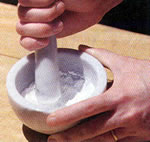Giving Medication by Mouth
- March 28, 2025
- ⎯ Christine Barakat
He has a respiratory infection that’s left him completely uninterested in his grain-and-antibiotic mixture. Your mare is a notoriously fussy eater. She turns up her nose, no matter how well you’ve hidden her thyroid medication under the applesauce.
Lacking the ability to convince a horse to take his medicine for his own good, every caretaker needs to be familiar with a safe, effective technique for giving oral medications via syringe. A practiced syringe-delivery technique ensures that full doses are ingested with minimum fuss.
With the help of a tasty “vehicle,” just about any crushed pill or powder can be loaded into a syringe and given orally. Coated or other specially treated pills may need to be given whole, however. Be sure to ask your veterinarian if grinding them is acceptable.
For this technique, you’ll need a two-ounce, catheter-tip “irrigation” syringe. Regular syringes and some deworming syringes have too narrow a tip for thick pastes to pass through. Catheter-tip syringes are available at surgical supply houses and also, most likely, from your veterinarian.
We’ve illustrated one veterinarian’s preferred method, which works well for delivering dewormers and your own medication mixes. For taller horses and shorter medics, or vice versa, you may want to adapt the technique as necessary. Do not try to hold the horse’s head still. Instead follow his movement until he accepts each phase of the procedure. If the horse is reasonably quiet, try draping the lead rope over his neck to free your hands. For more fractious horses, work in a stall and have a helper hold the lead loosely.
The tools you’ll need
If you plan to administer oral medications, here’s what you’ll want to have on hand:

- mortar and pestle
- two-ounce, catheter-tip “irrigation” syringe
- two-ounce shot glass with a rounded bottom
- some kind of “mixer,” such as lemon yogurt, molasses, baby food, applesauce or corn syrup
Preparation
The best concoctions for delivering medications are thick and sweet. Molasses, applesauce, baby food, yogurt, even pudding can be used as tasty vehicles for not-so-palatable medications.
Whatever your mixture, make sure it is sticky enough to stay in your horse’s mouth, but thin enough to push easily through a catheter-tip syringe.
Here are two serving suggestions. Ask your veterinarian which is more effective for the medication you plan to administer.
For medications that dissolve easily in water, such as most antibiotics, place the dose in a two-ounce shot glass. This is the perfect vessel, since a horse’s mouth can hold only two ounces. Plus the rounded bottom of the shot glass makes mixing and loading easier. Add just enough water to cover the pills and wait for them to absorb the liquid. Mix a small amount of molasses with the softened pills and load your syringe before the mixture has time to separate.
For medications that don’t dissolve readily, such as bute, you’ll need a mortar and pestle, which can be found at most kitchen supply stores. Grind the pills to a fine powder, mix with an ounce or so of fat-free lemon yogurt, and load your syringe. Stickier than its low-fat cousin, fat-free yogurt is a great medium for medication, and the lemon flavor doesn’t have syringe-clogging chunks of fruit.
The technique: Step by step
1. Face your horse, with his head at your left shoulder.
Hold the loaded syringe in your right hand and “show” it to the horse, moving it alongside his face, parallel with his lips.
2. Wrap the four fingers of your left hand around the noseband of his halter, just behind the lower right cheek ring.

3. Slip your left thumb inside his cheek at the corner of his mouth and pull the cheek out slightly, being aware of where his teeth are in relation to your thumb. Your hand should form a loose fist around the halter and lip. The horse may raise his head and fidget as you take hold–keep your thumb in place patiently and firmly until he accepts it. Holding the cheek along with the halter steadies you both and encourages the horse to open his mouth, giving you a doorway for the dose.
4. With your right hand, slip the tip of the syringe into the left side of the horse’s mouth, entering at the toothless bars.
Angle the tip up and back, over the tongue, as far as you can reach without poking the roof of his mouth. Though most horses accept the syringe quickly, others repeatedly bob their heads or turn their noses sharply left or right. Follow the motion until there is a moment of stillness.
5. With one quick squeeze, dispense the entire dose, following your horse’s head up if he flinches.
The object is to shoot as much of the preparation as possible over the back of the tongue, where it won’t dribble or be spit back out.
6. Immediately remove the syringe and your thumb, and let your horse lick the inside of his mouth clean.
7. For a high-strung horse or one that fusses, insert the syringe on the side where you are holding out the cheek.
This will take more dexterity on your part, but he won’t be able to avoid you by twisting his head to the left.





